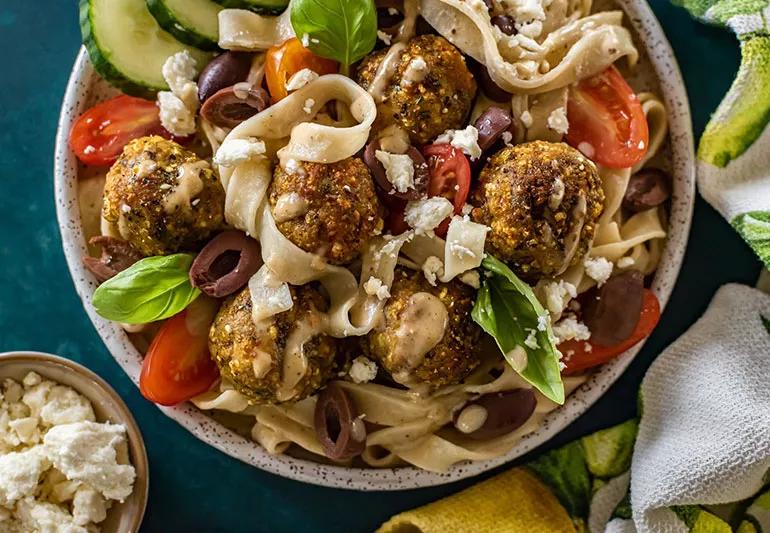Find out which foods could be causing IBS symptoms

If you have irritable bowel syndrome (IBS), you’re likely way too familiar with abdominal pain, bloating, constipation and diarrhea. But you might have the power to kick some of these symptoms to the curb. It starts with finding out which foods could be making your IBS symptoms worse.
Advertisement
Cleveland Clinic is a non-profit academic medical center. Advertising on our site helps support our mission. We do not endorse non-Cleveland Clinic products or services. Policy
But how do you know which foods are the problem? Enter the low-FODMAP diet — the detective for your gut. Registered dietitian and researcher Gail Cresci, PhD, RD explains the low-FODMAP diet and whether you should try it.
FODMAP stands for fermentable oligosaccharides, disaccharides, monosaccharides and polyols. FODMAPs are short-chain carbohydrates that you may have trouble digesting because:
Despite these traits, not all FODMAPs are the enemy. “Chances are, you can tolerate some — or most —FODMAP-containing foods,” says Dr. Cresci. “Plus, many healthy foods have FODMAPs in them, like dried beans/legumes, Brussels sprouts and apples. So you don’t want to cut out all high-FODMAP foods forever if they’re not bothering you. You just want to avoid or cut back on the few that don’t work for you.”
A team of researchers designed the low-FODMAP diet to relieve symptoms of IBS. The plan helps you determine which FODMAPs are giving you trouble and which ones are your friends. The diet follows three basic steps:
Advertisement
“Cutting out high-FODMAP foods in the first step resets your intestines so you can start with a clean slate,” says Dr. Cresci. “Introducing only one high-FODMAP food at a time allows you to pinpoint which foods, if any, are causing IBS flares. Then, you can build a new diet that improves IBS symptoms.”
The first step to starting a low-FODMAP diet is to get your healthcare provider’s approval and guidance. The restrictions in step one severely limit the foods you can eat and, over time, can lead to nutrient deficiencies. That’s why the first two steps of this plan are only meant to be temporary measures — not a long-term solution.
If you have IBS, try the low-FODMAP diet:
But don’t eliminate all high-FODMAP foods for more than a few weeks. “Your gut needs some high-FODMAP foods to optimally function,” says Dr. Cresci.
It can be overwhelming to eliminate all high-FODMAP foods in step one. But remember that this step is short-term. And there are plenty of low-FODMAP foods you can enjoy now to get you ready for steps two and three.
When you head to the grocery store, pick up some of these low-FODMAP foods:
Some fruits contain high amounts of sorbitol and fructose, which are monosaccharides and polyols — the M and P in FODMAP. Pick up these fruits for low-FODMAP alternatives:
Some vegetables contain oligosaccharides or polyols, which can irritate a sensitive gut. Pack your kitchen with these easier-to-digest veggies:
Many dairy products contain lactose, which is a disaccharide. Try these options instead.
Cheeses:
Meat marinades and sauces may contain various FODMAPs. Legumes (beans and pulses) are also high in oligosaccharides. Power up with these low-FODMAP proteins instead:
Many common breads and grains contain oligosaccharides, but you can avoid them if you choose:
Steer clear of artificial sweeteners commonly found in sugarless gum, mints and products labeled “sugar-free.” Satisfy your sweet tooth in moderation with these low-FODMAP options:
Advertisement
Studies show that the low-FODMAP diet can reduce or eliminate digestive problems in many people with IBS. But if it doesn’t work for you, don’t be discouraged.
“Not everyone will get amazing results from the plan, even if they follow it perfectly,” says Dr. Cresci. “If your symptoms don’t get better when you eliminate FODMAPs, then they probably aren’t a trigger for you. This information is useful because we can look at other possible IBS triggers, such as stress.”
IBS symptoms can be sneaky, but the low-FODMAP diet can uncover hidden triggers. “There’s no cure for IBS, but diet usually plays a big role,” says Dr. Cresci. “If you avoid the FODMAPs you can’t tolerate, you might start feeling a lot better.”
Advertisement
Learn more about our editorial process.
Advertisement

Choose foods that are low in fiber and easy to chew and swallow

The flexible eating plan aims to boost your brain health by focusing on plant-based foods and limiting saturated fat

Designed to lower your blood pressure, this eating plan focuses on heart-healthy foods like whole grains, fruits and vegetables

Pescatarians don’t eat poultry, game or red meat, but they do eat fish and seafood, dairy and eggs

This eating style has many health benefits, including weight loss, an improved microbiome, and increased nutrient and mineral consumption

Research shows promising results from options like the DASH diet and Mediterranean diet

Some people can safely lose weight on just 1,200 calories — but it’s not right for everyone

The Mediterranean diet, DASH diet or more plant-based eating plans can improve heart health

Babies can get congested easily, but you can calm their cough by keeping them hydrated, using nasal drops and running a humidifier

Weight loss may cause loose, sagging skin and muscle loss to your rear

Several conditions, like vitiligo and fungal infection, can cause a loss of pigmentation, leading to white spots or patches on your skin